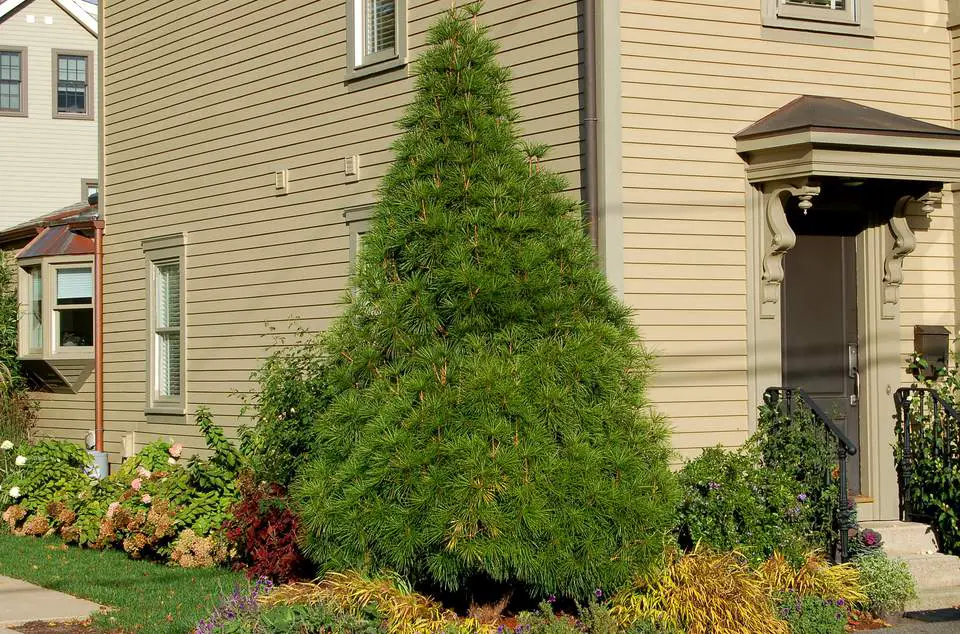A Beginner’s Guide On How To Transplant A Pine Tree Effectively
How to Transplant Pine Trees - A Guide To Wild Pine Transplant tree
Pine trees, also known as Christmas trees, are considered towering giants that are commonly seen in evergreen forests throughout the northern hemisphere. While there are over thirty different species of pine trees, they are all characterized by fragrant green needles and pine cones. Being relatively hardy plants, pine trees can be effectively transplanted to new areas and even relocated from wild environments to residential gardens. This article will act as a guide showing a person how to transplant a pine tree successfully. (Check out Plant City arborists for tree planting)
How Can I Transplant A Pine Tree Effectively?

Soure: www.thespruce.com
1. Choose The Transplant Site
The first step to effectively transplanting a pine tree is to choose the transplant site to be used. This is important as the site needs to be prepared before any transplanting can take place. It is recommended that the site chosen gains full sun exposure and is slightly elevated allowing for good drainage. The average pine tree will grow up to fifty feet tall; therefore, it is recommended that there is plenty of space for tree growth.
2. Digging The Tree Hole
The next step is to dig the hole for the transplanted pine tree. Before that, your gardening gloves should be necessary to protect your hands. Click here to know more.
An effective hole should be approximately twice as wide as the pine tree's current root balls, as well as deep enough to allow the roots to fit comfortably without any breaking or bending. It is advised that the hole dug is larger than you assume it should be because large holes can be filled with dirt. A hole that is too small, however, will 'crowd' the tree making tree growth more challenging.
3. Preparing The Soil
It is important to prepare the soil when transplanting pine trees. The soil preparation requires you to combine garden dirt with compost to a 50/50 mixture. While pine trees do not typically require much nutrition in the soil, additional compost will help nourish the plant and help the tree recover from any stress felt during transplantation.
4. Digging Up The Wild Pine
After the correct preparation has been made, it is time to dig up the pine tree from the wild environment. If you are transplanting several trees, it is recommended that you complete each transplant separately and singularly beginning with this step. Attempting to transplant all trees together will endanger the plants and reduce any growth.
When digging up the wild pine, it is recommended that you begin two feet from the tree trunk and move down into the soil toward the roots. Work outward and downward to locate the edges of the roots. Once the roots have been located, dig a circle around the plant forming a trench to reach underneath the ends of the tree's roots.
5. Lift The Tree Up
The next step is to push a shovel into the soil at an angle allowing it to slide below the existing roots of the pine tree. This will allow you to lever the shovel and push up the tree from the soil. Continue this procedure at several places around the pine tree until the core root is loose and the tree is lifted out of the soil. While the roots are lifted from the soil, it is advised that one take as much soil as possible with the roots during this step.
6. Keep The Roots Moist
If you are not travelling with the wild pine tree, it is advised that you wrap the core root in a moist towel to keep the roots protected during transportation. This will ease the transition of the tree over long distances; however, it is not necessary if the transplantation is happening over a short distance.
7. Planting The Tree
After moving the pine tree to its new site, it is time to plant the tree in the new location. Place the tree roots in the large hole and spread them carefully across the area, then fill the hole with the prepared planting soil. If, however, the tree's roots are encased in a soil ball it is necessary to place soil around the ball during planting. When filling the hole, you must pack the soil with a shovel or your hands to remove any air pockets in the hole.
8. Watering The Tree
The final step when transplanting a pine tree is to water the tree or trees. A pine tree requires a large amount of water, but do not water the soil until it is very wet - only moist. For the tree to grow successfully, it is important that you maintain this level of moisture and regularly water the tree.
What Mistakes Must Be Avoided When Transplanting Pine Trees?

Soure: mentalfloss.com
1. Overlooking The Power Of Soil
When transplanting a tree, it is important to remember that soil is a powerful resource and incorrect types of soil can influence the level of tree growth. If you are bringing soil to the new plant site, it is recommended that you sample the dirt beforehand. This sample will help test the soil for drainage and an appropriate soil PH level.
2. Planting During The Wrong Season
Believe it or not, the best time to transplant a pine tree is when the plant has become dormant. The dormant period is the season when energy is focused on root growth. Studies indicate that this would be during the fall period when temperatures are moderate and there is a moderate amount of rainfall. Some people will opt for early spring, but fall would be the ideal season for transplanting pine trees. However, no matter the occasion, you can find some helpful tools and items here for yourself or other gardeners.
3. Too Much Care
Contrary to popular belief, caring too much for a transplanted pine tree can cause more damage to the tree than good. Other than offering suitable watering and a layer of compost during transplanting, there is little that needs to be done when dealing with a pine tree. Some experts would not recommend immediate fertilizing of pine trees as the nitrogen could 'burn' the plant; however, this can be determined by performing a soil test before transplanting the tree. There is also a tip about how to grow plants like using led grow lights which provide good condition for some plants grown indoor.
Note: Transplanting a pine tree can be a reasonably simple procedure if you follow the correct guidelines. Using the information above, you can transplant a pine tree effectively and avoid the more common mistakes.
Transplanting a pine tree can be a daunting task for any gardener, but with the right knowledge and tools, it can be a successful endeavor. The best time to transplant a pine tree is during the tree’s dormant period, typically in early spring before new growth appears. The first step in transplanting a pine tree is to dig up the root ball, which should be twice as wide as the trunk and 12 inches deep. It’s important to keep the root ball moist during the transplant process and to use a shovel to loosen the soil around the tree trunk. Once the tree is dug up, it can be moved to its new location, where a hole should be dug that is 18 inches in diameter and 24 inches deep. Be sure to prepare the soil in the new planting hole and add mulch around the pine tree to help it thrive. Remember to also prune any damaged or dead branches before transplanting and to water the tree well after planting. To learn more about transplanting pine trees and other evergreen conifers, subscribe to our newsletter for tips and tricks on all things home improvement and gardening.
Digging And Transplanting The Pine Tree
Digging and transplanting a pine tree involves several steps to ensure that the tree can successfully adapt to its new location. The best time to transplant trees is in the spring or fall, when the weather is mild and the tree is not actively growing. Maple trees, unlike pine trees, can be transplanted year-round.
To begin, you will need to dig up the pine tree, being careful to preserve as much of the tree’s roots as possible. Use a sharp spade to dig around the side of the tree, making a trench about 6 inches away from the trunk. Carefully dig around the rootball of the tree, making sure to keep it intact. Once the tree is free from the ground, wrap a tarp around the rootball to keep the soil in place.
Next, prepare the planting location by digging a hole that is 12 inches in diameter and as deep as the rootball of the tree. Remove any rocks or debris from the hole, and loosen the soil with a shovel. Set the tree in the hole, making sure that the top of the rootball is level with the surrounding soil.
Fill the hole with soil, tamping it down gently around the rootball. Water the soil thoroughly, and wrap the tarp around the trunk of the tree to protect it from frost. Make sure to keep the soil moist, but not waterlogged, until the tree is established in its new home.
Transplanting a pine tree can be a challenging task, but with proper planning and care, your pine tree can thrive in its new landscape. Pine trees are known for their towering giants, green needles and can be a great pet for the nature lovers. Keep in mind that the success of a transplant also depends on the soil preparation, frost and the radius of the feet tall and deep the tree is going to be planted.
Steps to Successful Pine Planting
- Choose a suitable location for planting a pine tree in the northern hemisphere.
- Prepare the ground around the chosen location by removing any debris or obstructions.
- Select a healthy pine tree for transplanting, taking care to ensure that the tree doesn’t have any visible damage or disease.
- Carefully dig up the tree, being mindful not to damage the roots, and remove it from its current location.
- Place the tree in the hole, making sure that the roots are spread out evenly around the root ball.
- Fill in the hole with soil, tamping it down gently to remove any air pockets.
- Water the tree thoroughly and add a layer of mulch around the base of the tree.
- Give the tree time to adjust to its new location by providing it with regular watering and care. It’s the best time to transplant all trees is during the dormant season.
- Be aware that wild pines often present different requirements than cultivated varieties, so make sure to research the specific tree requires.
- Keep an eye on the tree’s progress and make adjustments as needed to ensure that the roots must receive enough moisture and nutrients.
What is the best time of year to transplant a pine tree?
The best time to transplant a pine tree is in the dormant season, typically late fall or early winter when the tree is not actively growing. This is the time when evergreen trees like pines are at their least active state, making it the best time to move them to their new location without causing unnecessary stress on the tree. When transplanting, it is important to follow a guide on how to transplant, taking care to keep as much of the root ball intact as possible. Pines often present as tall trees with straight trunks, but the genus also includes smaller saplings. When transplanting the tree, it is important to dig the hole for the new site at least 2 feet deep and 2 inches in diameter for every inch of the trunk’s diameter. It is also important to make sure the soil is not too wet or frozen, and that the weather is not too cold or hot. Late winter or early spring is also a good time to transplant a pine tree. It is best to avoid transplanting during the hot summer months when the tree is actively growing. When transplanting, it is important to make sure the tree is protected from the summer heat and is given enough time to grow in its new location. The genus of pines also includes deciduous or evergreen trees. After transplanting, it is important to add a layer of mulch around the base of the tree to help the tree thrive in its new location. Ultimately, the best time to transplant a tree depends on the tree type, but spring and fall are generally good seasons to move a tree.
Conclusion
In conclusion, transplanting pine trees can be a rewarding and relatively straightforward process, as long as you take the time to prepare and care for the tree throughout the process. By following the steps outlined in this post, you can successfully transplant a pine tree to its new location, giving it the best chance to grow and thrive. Remember to choose a healthy tree, prepare the ground around the new location, handle the tree’s roots with care, and provide regular watering and care after transplanting. With proper care, your pine tree will soon be an established and healthy addition to your landscape. It’s important to research the specific requirements of the tree you are transplanting, wild pines often present different needs than cultivated varieties. Happy planting!
Frequently Asked Questions (FAQs)
If you’ve still got questions about How to transplant a pine tree, then these may help
How To Plant a Pine Tree From Seed
To plant a pine tree from seed, follow these steps:
- Choose a new location for the tree, making sure it has well-draining soil and receives adequate sunlight.
- Determine the best time to plant the tree, which will depend on the climate and local weather conditions.
- Carefully remove the tree from its current container, being mindful not to damage the tree roots.
- Dig a hole in the ground around the tree’s new location that is slightly larger than the container the tree is currently in.
- Place the tree in the hole and gently spread out the roots around the ball of soil.
- Backfill the hole with soil and firm the ground around the tree to secure it in place.
- Water the tree thoroughly to help it establish itself in its new location.
Note: If the tree is already established in a pot it’s better to move it to its new location at the same time of the year it would naturally go dormant.
Should I transplant trees in winter?
It is generally not recommended to transplant trees during the winter months. The best time to transplant trees is during their dormant period, which is typically in the fall or early spring before new growth begins. Transplanting a tree during the winter can stress the tree, making it harder for the tree to grow and establish itself in its new location. The reason is that during the winter months, tree roots are less active and less able to absorb water and nutrients which can cause them to die. Therefore, it is best to wait until the dormant period to move trees, when they are less likely to experience stress and have a better chance of successfully establishing themselves in their new location.
How big of a pine tree can you transplant?
The size of a pine tree that can be successfully transplanted depends on several factors, including the tree’s age and species, the time of year it is being transplanted, and the care taken during the transplanting process. In general, it is easier to successfully transplant a younger and smaller tree than an older and larger one.
As a rule of thumb, it is generally recommended to transplant trees that are less than 6-8 feet tall and have a trunk diameter of less than 2 inches. These trees will have a smaller root system and will be less likely to experience stress during the transplanting process.
However, if a larger tree needs to be moved, it can be done but it’s more complex and it requires more resources and professional help. It’s important to keep in mind that moving a large tree can be a difficult and risky process that should be done by a professional arborist with the proper equipment and experience. This is because, the larger the tree, the more extensive the root system is and the more difficult it is to dig up and move without causing damage.
Is it better to transplant trees in the spring or fall?
It is generally considered best to transplant trees in the fall or early spring, when they are in their dormant period. This is because, during this time, the tree’s leaves have fallen off and its energy is focused on its root system, making it less likely to experience stress during the transplanting process. Additionally, the soil is typically more moist during these seasons, which can help with the tree’s establishment in its new location.
Transplanting in the spring is also a good option, before the tree starts new growth. However, it’s important to do it before the tree’s buds have swollen, because once new growth starts, it will be harder for the tree to adjust to its new location.



